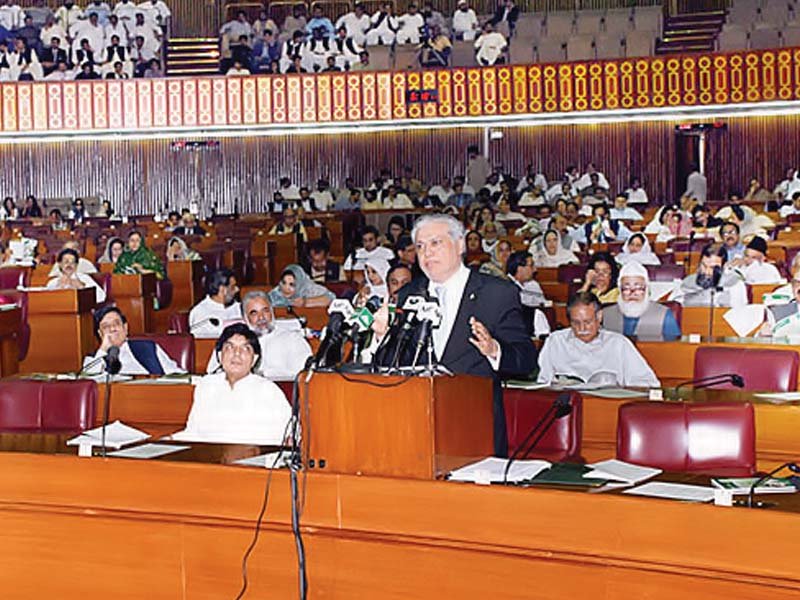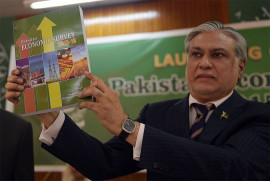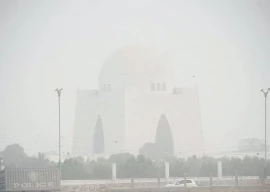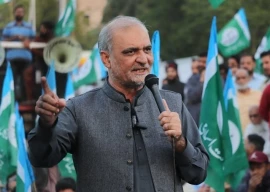
ISLAMABAD: The federal government on Friday unveiled a 4.4-trillion-rupee deficit budget with packages for agriculture and industrial sectors to stimulate growth, though allocations for these incentives remain elusive.
Lawmakers from opposition parties protested the delay in finalisation of a new National Finance Commission award as Finance Minister Ishaq Dar announced the federal budget for the fiscal year 2016-17 in the lower house of parliament.
The government aims to lower the deficit to Rs1.615 trillion, or 4.8% of GDP, in the upcoming financial year. However, the deficit target seems understated, as the government has also not fully taken into account the implications of grants and other expenses. The overall deficit target is at 3.8% of GDP, or Rs1.28 trillion, on back of Rs339 billion savings by the four provinces.
The chronic power crisis is unlikely to abate as the finance minister gave a March 2018 deadline for ending load shedding. Neither did he announce measures to reform the Federal Board of Revenue and Public Sector Enterprises nor did he mince his words on the privatisation policy. He did not spell out any plan to end circular debt either.
As the finance minister stood in his seat to present the PML-N government’s 4th budget, Leader of Opposition in the National Assembly Khursheed Shah protested against the delay in finalisation of a new NFC award. The last award lapsed a year ago. “The delay is in violation of the Constitution and tantamount to usurping the rights of the federating units,” Shah said.
Dar soberly protested against Shah’s intervention before starting his budget speech. Like his previous two speeches, the finance minister ostensibly struggled in striking a balance in maintaining fiscal consolidation and giving incentives to agriculture and industrial sectors. However, many of industrial and textile incentives he announced were already under implementation and appeared just rhetoric.
While acknowledging the setbacks to the agriculture sector, Dar announced a special package but allocation for picking up cost of lowering fertiliser and electricity prices remained elusive. Either the agriculture package will remain unfunded like the much-touted Kissan Package or the Rs4.4trillion budget will become irrelevant due to expenses overruns, according to experts.
The government announced a host of taxation measures, which would further squeeze the take-home incomes. One of the aggressive measures was restricting the tax-free cash withdrawal and banking transaction facility to just one account. Due to taxation measures, prices of education, electricity, milk, construction material and consumers goods will go up. Big corporations will also face squeeze in their incomes, as the government again heavily taxed the already overburdened sectors.
Dar announced a 10% ad-hoc increase in salaries and pensions of government employees in addition to merging two previous allowances into the basic salary.
The defence spending will rise by over one-tenth, and the social spending will see a marginal increase. An amount of Rs115 billion has been allocated for the Benazir Income Support Programme (BISP), up from Rs107 billion.
The estimated size of federal expenditures is Rs4.4 trillion, 7.3% up from FY 2015-16, said Dar while sharing details of the budget. There is a black hole of Rs1.6 trillion that the government will fill by borrowing from banks.
Dar also proposed two significant amendments in the Fiscal Responsibility and Debt Limitation Act of 2005 to restrict the budget deficit to 4% in FY 2017-18 and to limit it at 3.5% of GDP. Another significant amendment is setting new limits for total public debt which, Dar said, would be gradually reduced to 50% of GDP over the next 15 years.
Of Rs4.4 trillion, the size of the current expenditure is Rs3.4 trillion. The cabinet has approved Rs140.6 billion subsidies for the next fiscal, which are underreported, as the government did not include the impact of Rs3.50 per unit reduction in electricity prices for agriculture tube-wells in the budget.
The defence budget has been proposed at Rs860 billion, higher by Rs75 billion over FY2016-17’s revised spending. An amount of Rs352.8 billion has been proposed for running the civilian government – up by only 6.8%. Another Rs245 billion have been set aside for paying pensions to both retired militarymen and civilians.
A major chunk of Rs442 billion has been allocated under the head of grants and transfers, including Rs190 billion contingent liabilities for defence procurements.
The four provinces will get Rs2.13 trillion as their share in the federal taxes, which will be 15% higher than the outgoing fiscal year. Punjab will get the lion’s share, i.e. Rs1.05 trillion, Sindh Rs547.8 billion, Khyber-Pakhtunkhwa Rs346.2 billion, and Balochistan Rs196.8 billion.
Special initiatives
After the slum in the agriculture sector in FY2015-16, Dar said the government has decided to give the biggest agriculture package in the country’s history in the new financial year. He blamed declining commodity prices and unfavourable weather conditions for the collapse of the agriculture sector.
He announced two major measures, a cut in prices of fertilisers and electricity but both remain largely unfunded. Dar said fertiliser prices will be reduced from Rs1,800 per bag to Rs1,400. Fertiliser manufacturers will reduce Rs50 per bag price, while the remaining Rs350 will be picked by the government, which will cost Rs36 billion, to be equally shared by federal and provincial governments. However, the budget-in-brief document is silent on it even though the cabinet approved the budget on May 30.
Dar also announced that the agriculture credit target is being increased to Rs700 billion However, it does not have a bearing on the budget. He said the government through the State Bank will develop a framework to reduce mark-up rates of ZTBL, NBP, Bank of Punjab and Punjab Co-operative by 2%.
Another important measure is concessional electricity tariff for agriculture tube-wells.
Export Promotion
Barring a few, most of the measures announced for export promotions were just rhetoric. Among the new measures was reduction in mark-up rate on export refinancing facility from 3.5% to 3% from July 1. To encourage Small and Medium Enterprises (SMEs) to invest in new technologies, especially in non-traditional exports, a technology upgradation fund (TUF) is being established.
Importantly, a zero-rating tax regime for five export-oriented sectors: textile, leather, sports goods, surgical goods and carpets, has been proposed from FY2016-17. For the textile sector, duty-free import of machinery was also announced in addition to withdrawing customs duty on import of manmade fibers.
Industrial package
The government also announced an industrial package which includes doubling tax credit limit on every 50 jobs generated by an industrial undertaking; increasing tax credit for making sales to registered persons from 2.5% to 3% of tax payable, increasing tax credit for balancing, modernisation and replacement (BMR) of plant and machinery was to 20% of investment against tax payable for five years.
The tax credit for establishing a new industry will now be available on 70% equity.
Published in The Express Tribune, June 4th, 2016.























































COMMENTS
Comments are moderated and generally will be posted if they are on-topic and not abusive.
For more information, please see our Comments FAQ